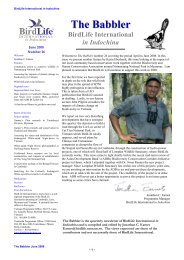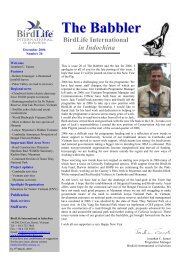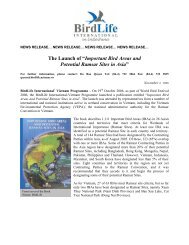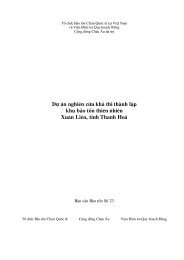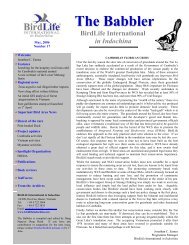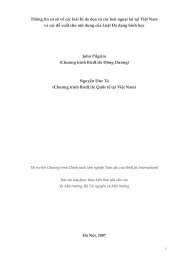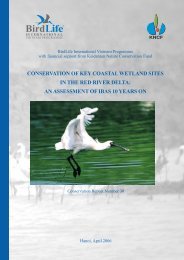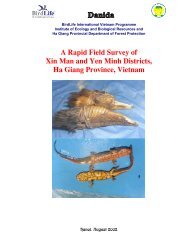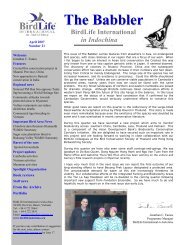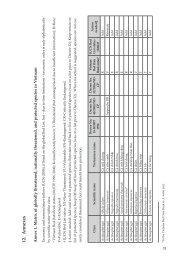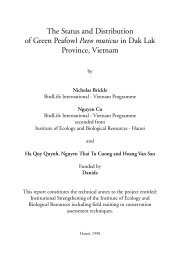VN049 Kon Plong - Birdlife International in Indochina
VN049 Kon Plong - Birdlife International in Indochina
VN049 Kon Plong - Birdlife International in Indochina
You also want an ePaper? Increase the reach of your titles
YUMPU automatically turns print PDFs into web optimized ePapers that Google loves.
<strong>VN049</strong> <strong>Kon</strong> <strong>Plong</strong><br />
<strong>Kon</strong> <strong>Plong</strong> Criteria: A1, A2 & A3<br />
Prov<strong>in</strong>ce(s): <strong>Kon</strong> Tum<br />
PA Status: None<br />
Latitude: 14º46'N<br />
Longitude: 108º20'E<br />
Area: 65,077 ha<br />
Altitude Range: 1,100-1,757 m asl<br />
EBA / SA:<br />
<strong>Kon</strong> Tum Plateau EBA<br />
Priority Landscape:<br />
CA1 - Central Annamites<br />
General Description<br />
Situated on the <strong>Kon</strong> Tum plateau, the IBA comprises the <strong>Kon</strong> <strong>Plong</strong> Forest Complex, which <strong>in</strong>cludes Manh Canh II<br />
and Tan Lap State Forest Enterprises and Ngoc Tem Watershed Protection Forest. The topography of the IBA<br />
consists of a montane plateau dissected by a complex of valleys. The highest po<strong>in</strong>t <strong>in</strong> the IBA is Mount Ngoc Boc at<br />
1,757 m asl. The natural vegetation of <strong>Kon</strong> <strong>Plong</strong> IBA is lower montane evergreen forest, <strong>in</strong>clud<strong>in</strong>g a number of<br />
forest formations dom<strong>in</strong>ated by conifers. However, more than 75% of the total area of the IBA has been degraded by<br />
human activities, pr<strong>in</strong>cipally commercial logg<strong>in</strong>g, and now supports a range of secondary habitats, <strong>in</strong>clud<strong>in</strong>g<br />
regenerat<strong>in</strong>g forest, bamboo forest, grassland and scrub 1 .<br />
Bird Fauna: Key Features<br />
<strong>Kon</strong> <strong>Plong</strong> IBA is situated <strong>in</strong> the <strong>Kon</strong> Tum Plateau Endemic Bird Area (EBA). The IBA supports seven restrictedrange<br />
bird species: more than are known to occur at any other site <strong>in</strong> the EBA. Most significantly, the IBA supports<br />
two species whose global ranges are conf<strong>in</strong>ed to the EBA: Golden-w<strong>in</strong>ged Laugh<strong>in</strong>gthrush Garrulax ngocl<strong>in</strong>hensis<br />
and Chestnut-eared Laugh<strong>in</strong>gthrush G. konkak<strong>in</strong>hensis. Although the forest at <strong>Kon</strong> <strong>Plong</strong> IBA is more degraded and<br />
fragmented than that at other IBAs <strong>in</strong> the <strong>Kon</strong> Tum Plateau EBA, two globally near-threatened hornbill species have<br />
been recorded: Brown Hornbill Anorrh<strong>in</strong>us tickelli and Great Hornbill Buceros bicornis. It is unlikely, however, that<br />
the IBA regularly supports a significant population of the latter species 1 .<br />
Species IBA<br />
Criteria<br />
Crested Argus<br />
Rhe<strong>in</strong>ardia ocellata<br />
Golden-w<strong>in</strong>ged Laugh<strong>in</strong>gthrush<br />
Garrulax ngocl<strong>in</strong>hensis<br />
†Great Hornbill<br />
Buceros bicornis<br />
Brown Hornbill<br />
Anorrh<strong>in</strong>us tickelli<br />
168<br />
Global<br />
Threat<br />
Status<br />
Other<br />
IBAs<br />
Notes<br />
A1, A2 VU 15 T he species was heard on several occasions <strong>in</strong> primary<br />
forest on Mount Ngoc Boc between December 2000 and<br />
January 2001 1 .<br />
A1, A2 VU 1 A flock of at least three birds was observed at 1,480 m asl<br />
on Mount Ngoc Boc <strong>in</strong> early January 2001 1 .<br />
A1 NT 13 A feather belong<strong>in</strong>g to this species was found on Mount<br />
Ngoc Boc <strong>in</strong> January 2001 1 . T he site probably does not<br />
regularly support a significant population of this species.<br />
A1, A3 NT 16 T he species was recorded on five occasions between<br />
December 2000 and January 2001, <strong>in</strong>clud<strong>in</strong>g flocks of 15<br />
birds on two occasions 1 .<br />
A1, A2 NT 11 T he species was recorded on four occasions between<br />
December 2000 and January 2001 1 .<br />
A1, A2 NT 8 T he species was recorded on numerous occasions<br />
between December 2000 and January 2001 1 .<br />
A1, A2 NT 17 S<strong>in</strong>gle birds were recorded on three occasions between<br />
December 2000 and January 2001 1 .<br />
A2 8 A flock of 10 birds and a flock of 40 were recorded <strong>in</strong><br />
Yellow-billed Nuthatch<br />
Sitta solangiae<br />
Black-hooded Laugh<strong>in</strong>gthrush<br />
Garrulax milleti<br />
Short-tailed Scimitar Babbler<br />
Jabouilleia danjoui<br />
White-cheeked Laugh<strong>in</strong>gthrush<br />
Garrulax vassali<br />
December 2000 1 .<br />
Chestnut-eared Laugh<strong>in</strong>gthrush<br />
Garrulax konkak<strong>in</strong>hensis<br />
A2 1 T he species was recorded on a number of occasions<br />
between December 2000 and January 2001 1 .<br />
Notes: † = not confirmed to regularly occur <strong>in</strong> significant numbers.<br />
Directory of Important Bird Areas <strong>in</strong> Vietnam
<strong>VN049</strong> <strong>Kon</strong> <strong>Plong</strong><br />
Biome Restricted Species: The site qualifies under criterion A3 because it supports 29 species restricted to the<br />
S<strong>in</strong>o-Himalayan Subtropical Forests (Biome 08). See Appendix 4 for details.<br />
Secondary Criteria<br />
Species Status<br />
[Northern Slow Loris Nycticebus bengalensis]<br />
Species Status<br />
1 DD [Elongated Tortoise Indotestudo elongata] 1<br />
[Pygmy Loris Nycticebus pygmaeus]<br />
EN<br />
1<br />
VU [Impressed Tortoise Manouria impressa] 1 VU<br />
Northern Pigtail Macaque Macaca leon<strong>in</strong>a 1 VU P<strong>in</strong>us merkusii 1 Stump-tailed Macaque Macaca arctoides<br />
VU<br />
1 VU Podocarpus neriifolius 1<br />
Grey-shanked Douc Pygathrix nemaeus c<strong>in</strong>erea<br />
DD<br />
1 VU Cephalotaxus mannii 1 VU<br />
Buff-cheeked Gibbon Nomascus gabriellae 1<br />
VU Southern Serow Naemorhedus sumatraensis 1 Big-headed T urtle Platysternon megacephalum<br />
VU<br />
1 EN<br />
Notes: [ ] = unconfirmed record.<br />
Threats to Biodiversity<br />
The major threat to biodiversity at <strong>Kon</strong> <strong>Plong</strong> IBA is commercial timber extraction. A large proportion of the IBA is<br />
under state forest enterprise management, and timber extraction is currently tak<strong>in</strong>g place at unsusta<strong>in</strong>able levels.<br />
Other significant threats <strong>in</strong>clude hunt<strong>in</strong>g and over-exploitation of NTFPs, both of which take place for domestic<br />
consumption and <strong>in</strong> response to commercial demand.<br />
Clearance of forest for agriculture is currently not a<br />
major threat to biodiversity at the IBA but may<br />
become so <strong>in</strong> the future if the local human population<br />
<strong>in</strong>creases as a result of natural population growth or<br />
settlement of migrants. In this context, another<br />
potential threat is construction of roads through the<br />
IBA, which could act as foci for human settlement 1 .<br />
As well as affect<strong>in</strong>g the IBA directly, commercial forestry operations, road construction and subsequent human<br />
settlement and clearance of forest for agriculture may result <strong>in</strong> loss of contiguous areas of natural forest that<br />
currently l<strong>in</strong>k <strong>Kon</strong> <strong>Plong</strong> IBA with Ngoc L<strong>in</strong>h IBA to the north and <strong>Kon</strong> Ka K<strong>in</strong>h and <strong>Kon</strong> Cha Rang IBAs to the<br />
south.<br />
Conservation Actions<br />
• Dur<strong>in</strong>g 2000, the World Bank-WWF Forest Alliance and the Tropical Forest Trust began develop<strong>in</strong>g a project<br />
to promote susta<strong>in</strong>able forest management with<strong>in</strong> the IBA, entitled Susta<strong>in</strong>able forest management and<br />
biodiversity conservation <strong>in</strong> the <strong>Kon</strong> <strong>Plong</strong> Forest Complex. This project has yet to beg<strong>in</strong> implementation.<br />
Recommendations<br />
• Susta<strong>in</strong>able forest management practices should be <strong>in</strong>troduced at Manh Canh II and Tan Lap State Forest<br />
Enterprises 1 .<br />
• Susta<strong>in</strong>able exploitation of natural resources, particularly wild animals and NTFPs, should be promoted among<br />
local communities.<br />
• Biodiversity considerations should be <strong>in</strong>tegrated <strong>in</strong>to plans for <strong>in</strong>frastructure development and human<br />
settlement with<strong>in</strong> the IBA, <strong>in</strong> order to mitigate potential negative impacts.<br />
References<br />
Threat Severity<br />
Agricultural <strong>in</strong>tensification / expansion ●<br />
Commercial timber extraction ● ● ●<br />
Hunt<strong>in</strong>g ● ●<br />
Infrastructure development ● ●<br />
Selective logg<strong>in</strong>g / cutt<strong>in</strong>g ●<br />
Unsusta<strong>in</strong>able exploitation of NTFPs ● ●<br />
1. Eames, J. C., Kuznetsov, A. N., Monastyrskii, A. L., Nguyen Tien Hiep, Nguyen Quang Truong and Ha Quy<br />
Quynh (2001) A prelim<strong>in</strong>ary biological assessment of the <strong>Kon</strong> <strong>Plong</strong> forest complex, <strong>Kon</strong> Tum prov<strong>in</strong>ce,<br />
Vietnam. Hanoi: WWF Indoch<strong>in</strong>a Programme.<br />
2. BirdLife <strong>International</strong> and the Forest Inventory and Plann<strong>in</strong>g Institute (2001) Sourcebook of exist<strong>in</strong>g and<br />
proposed protected areas <strong>in</strong> Vietnam. Hanoi: BirdLife <strong>International</strong> Vietnam Programme and the Forest<br />
Inventory and Plann<strong>in</strong>g Institute.<br />
Directory of Important Bird Areas <strong>in</strong> Vietnam 169




